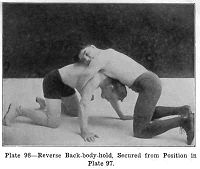
Back مصارعة الإمساك Arabic Catch Wrestling German Κατς Greek Catch wrestling Spanish کشتی کچ Persian Koukkupaini Finnish Catch wrestling French Catch wrestling Italian キャッチ・アズ・キャッチ・キャン Japanese 캐치 레슬링 Korean
 | |
| Also known as | Catch-as-catch-can (CACC) Lancashire wrestling Loose-hold Hooking Rough and tumble Fair fight Shoot wrestling |
|---|---|
| Focus | Wrestling, Grappling |
| Country of origin | United Kingdom |
| Famous practitioners | (see notable practitioners) |
| Parenthood | English wrestling (primarily Lancashire style, with influence from Cumberland, Westmorland, Cornish, Devonshire wrestling) Indian pehlwani[1][2] Irish collar-and-elbow, Greek pankration, American rough and tumble |
| Descendant arts | Freestyle wrestling, professional wrestling, shoot wrestling, Brazilian jiu-jitsu, folkstyle wrestling, Luta Livre, Sambo, mixed martial arts (MMA) |
| Olympic sport | Yes (as amateur freestyle wrestling) since 1904 |
Catch wrestling (also known as catch-as-catch-can) is an English wrestling style where wrestlers aim to win by pinning or submitting their opponent using any legal holds or techniques. It emphasizes adaptability and seizing opportunities during the match, with fewer restrictions than other wrestling styles - techniques using or targeting the legs are allowed, submissions are allowed, and there are no mandatory grips. It was spread by wrestlers of travelling funfairs who developed their own submission holds, referred to as "hooks" and "stretches", into their wrestling to increase their effectiveness against their opponents, as well as immigrants through Europe and the Anglosphere.
Catch-as-catch-can was included in the 1904 Olympic Games and continued through the 1936 Games; it had new rules and weight categories introduced similar to other amateur wrestling styles, and dangerous moves - including all submission holds - were banned. New rules and regulations were later developed and codified by FILA and amateur catch wrestling became known as freestyle wrestling, which was then considered separate from the dangerous, professional catch style.[3][4] After a revival effort starting in the 1980s, competitive catch wrestling gradually made a return, leading to The Snake Pit's Catch Wrestling World Championships and notable competitions such as the Snake Pit British Championships and ACWA US Open.[5]
Professional wrestling, once a legitimate combat sport, was competitive catch wrestling. The original and historic World Heavyweight Wrestling Championship was created in 1905 to identify the best catch-as-catch-can wrestler in the world, before the belt was retired in 1957 and unified with the NWA World Heavyweight Championship. Modern day professional wrestling has its origins in wrestling matches where predetermined ("worked") matches had elements of performing arts introduced (as well as striking and acrobatic manoeuvres), turning it into an entertainment spectacle.[6] In a few countries, such as in France and Germany, "catch" is still the term used for professional wrestling.[7]
In the UK, catch wrestling combines several British styles of wrestling (primarily Lancashire,[8] as well as Cumberland, Westmorland,[9] Devonshire[9] and Cornish) along with influences from the Irish collar-and-elbow and Indian pehlwani[1][2] styles of wrestling. The training of many modern submission wrestlers, professional wrestlers, and mixed martial artists is founded in catch wrestling through its various descendant styles. Other martial arts with origins in catch wrestling include folkstyle wrestling, Sambo, Luta Livre, shoot wrestling, shootfighting and mixed martial arts (MMA).[citation needed][10]
- ^ a b Cite error: The named reference
Manillawas invoked but never defined (see the help page). - ^ a b Cite error: The named reference
Naurightwas invoked but never defined (see the help page). - ^ International Federation of Associated Wrestling Styles. "Freestyle Wrestling". FILA. Archived from the original on 11 July 2011. Retrieved 28 October 2008.
- ^ Nash, John S. (13 August 2012). "The Olympic History of Catch Wrestling". Bloody Elbow. Retrieved 5 November 2021.
- ^ Lindsey, Alex (25 December 2023). "AIGA 2023 & Catch Wrestling US champions crowned". bloodyelbow.com. Retrieved 1 December 2024.
- ^ Slack, Jack (4 February 2016). "Kayfabe Time Capsule: The Real Techniques of Professional Wrestling". Fightland. Archived from the original on 8 November 2020. Retrieved 31 October 2019.
- ^ "Catch : l'histoire d'un sport spectacle marié avec la télé du 09 mars 2013". France Inter (in French). 9 March 2013. Retrieved 25 February 2023.
- ^ "Submission Wrestling". aspullolympicwrestlingclub.co.uk. Archived from the original on 7 April 2005. Retrieved 19 November 2019.
- ^ a b Armstrong, Walter (1890), Wrestling
- ^ Nauright, John; Zipp, Sarah (2020). Routledge Handbook of Global Sport. Routledge. p. 179. ISBN 978-1-317-50047-6.